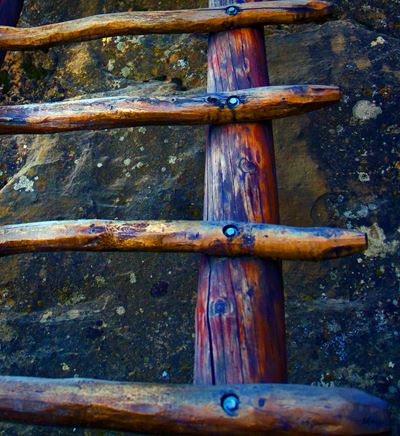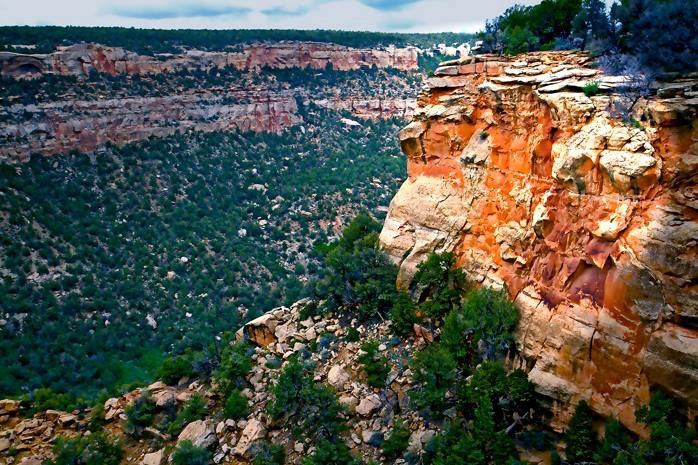Career ladder short? Channel ancient hands
- Joanne Markow
- Jun 7, 2015
- 5 min read
Location: Mesa Verde, Colorado | Balcony House

We were en route to a mystical destination...with a 35-foot hand-carved spruce tree ladder to transport us through the final stretch. Evoking hope, eagerness, competitiveness and fear, the ladder triggered a vision of heroes long ago, ascending rough terrain. Symbol of something special? You bet.
We're a motley crew, us humans. And no matter the century, we never disappoint.
The ladder from 1930 was designed to bring pairs of people, rung after rung higher. To where? That's only partially relevant.
The why? Now that's intriguing.
The Ascent
I hung back to observe. There was the proud father filming his son's every step, the fearless child zooming ahead to be first, the GoPro camera duo capturing each other, the racer leaping up effortlessly, and the timid whisperer expressing doubt.
Ladder leading to Balcony House photo © 2015 by Joanne Markow
Selfie posers halted progress of those behind them, the achiever boasted of past accomplishments, the helper assisted others, the weary panted from their last steps, and the funny gentleman rallied the troops.
Everyone is here, waiting in anticipation for the climb. We looked upward.
And in true American fashion, you could hear:
"Do you want to go together?"
"No, what do you really need me beside you the whole way?"
Yup, those two guys staggered themselves independently the entire trip up.
But the couple in matching bright green coats climbed coordinated as a team.

Looking up the ladder leading to Balcony House photo © 2015 by Joanne Markow
Thoughts...
Do we climb together?
Do we go it alone?
Should we look ahead or below us?
Am I in need of support and encouragement to keep going?
What are we leaving behind and what are we about to gain?
The Descent
I didn't descend by the ladder. We left by a different path and method.
Why? For flow.
In life, we often only talk about the "ladder of success" or a "career ladder" or "career path" as if there is only one direction under which you move. And that direction is seemingly always up.
But life isn't one dimensional, with one tool or structure in which to ascend. Your career flow can happen in all directions you desire—up, down, sideways.
To rise up, you may need to descend first. So, keep moving.
Ugh. I Climbed the "Wrong" Wall!
Life is about decisions. About learning every day.
“There is perhaps nothing worse than reaching the top of the ladder and discovering that you’re on the wrong wall.” ― Joseph Campbell
Interesting perspective. But, don't quite agree...
Why not let yourself discover the "wrong wall" more often? What in the world is a "wrong wall" in life anyway? Everything is relative in the moment. Climb up and down repeatedly. Fall off the ladder. Skip the ladder. Take some risks. Just get yourself moving and learning every day.
Figure out your intent, lean your ladder, and go for it! Organizations who move quickly and take risks offer plenty of walls onto which you can leave your mark, scale higher, peer over with curiosity, and jump off.
The Views
I stepped off the ladder at Mesa Verde, Colorado, to admire the scenery, landscape, sounds, air and to take a peek down where I'd been earlier that day.
Amazing how beautiful all views are at each height. So important to notice.
Whom do you see when you look down? What kind of image do they see upon looking back up at you? What contributions and value do you leave along the way? Consider the various perspectives when you're a leader of a group or making a shift across teams.

View of the environment at Mesa Verde © 2015 by Joanne Markow
Road Map to Career Achievements
Are ladders absolutely necessary? No.
Are there other ways to climb? Yes.
Is it easier to see the path and do you have a more structured experience with a ladder? Of course.
Ladders create visible steps—concrete goals toward an intended direction, which is comforting in times of ambiguity. Ladders provide a measurement of progress in chunks. The climber has the ability to see new perspectives in small phases the higher the elevation. And "seeing" leads to wisdom. Let's face it, ladders help you advance higher at a steady pace.
Your peers observe you too. They learn your character traits in handling the ascent alone or in sync with a partner. What you say along the way and how you make others feel is lasting on your climb higher.
There are the "before and after" decisions, viewpoints and preparations, but the climb is the journey. You can choose to look back down or only look forward. The choice is strictly yours as well as whom you bring along the way. Who designs the ladder though―you or someone else?
Creators of Ladders
People who have the vision for new heights do so because they know there is way to get there. They are architects, dreamers, inventors and prove to the world anything is possible. Maybe this is you? Or maybe someone before you? These creators can help provide stepping stones and development for you.
I visited cliff dwellings from 800 years ago built by the Ancient Pueblo peoples who inhabited the extraordinarily high and treacherous locations from 1190 to 1300 CE across a 10,000 mile region throughout the Southwestern United States. Born from subterranean environments starting in 600 CE, treasuring mud layering and richness of the ground, the Ancient Puebloans pivoted drastically to living in cliff dwellings situated in natural sandstone crevices created by the ancient sea bed in North America.

View of Cliff Palace, Mesa Verde© 2015 by Joanne Markow.
Why the extreme shift to new heights? To survive. And to advance their lives. To create a better life and to harvest better crops. To live in communal areas protected from the elements. Their careers as farmers, cooks and mothers depended on their new locations to keep them safe. As in business or life, we must do the same.

Balcony House photo © 2015 by Joanne Markow
To climb and grow in their new roles and new environments, Ancient Puebloans invented footholds and handholds directly in the sandstone. They didn't need a tool but climbed hand-over-hand to the upper mesa crops and back down to ravines. They carved elaborate, lengthy staircases too in rocks to cover greater distances. Wooden ladders were used to descend or ascend into kivas or into second or third floor cliff dwelling housing. Ropes were handmade for accelerating drops and climbs. The Ancient Puebloan people knew how to get to where they needed to, despite any setbacks, challenging paths or extreme risk in the process. They had faith and believed in themselves. And their new homes where water seeped through limestone, fire burned brightly, and turkeys could be protected.
And they did it all with their own hands, building and climbing every day.
They were visionaries, designers and innovators. Successful risk takers. A great example for us today.
Photographs in the article were taken at Mesa Verde National Park © 2015 by Joanne Markow.



